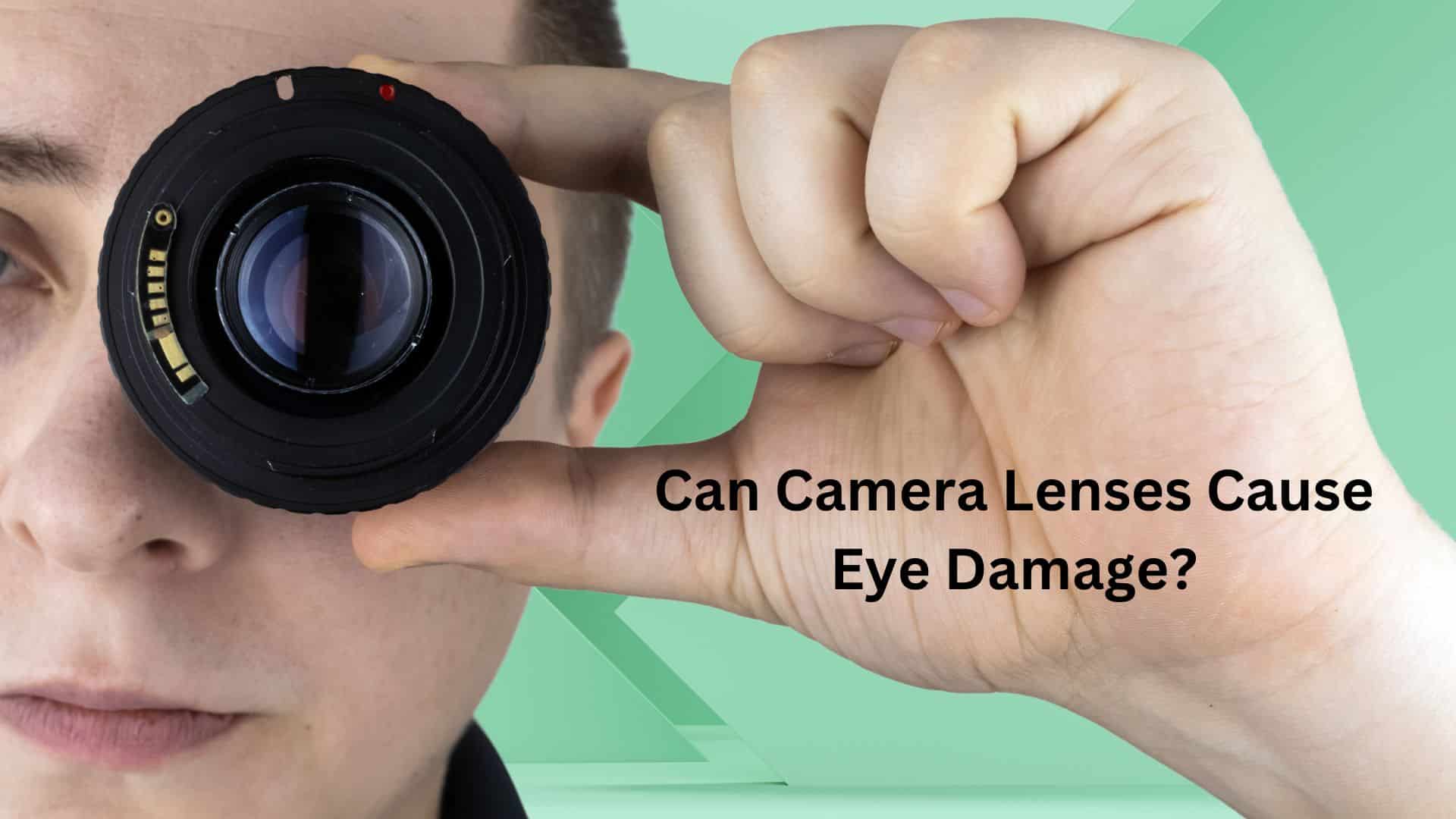Many photographers have likely wondered at some point – Can Camera Lenses Cause Eye Damage? In today’s digital age, where smartphone cameras and DSLRs have become ubiquitous, concerns about the potential harm caused by camera lenses to our eyes have arisen. While camera lenses are primarily designed to capture stunning images, it is essential to address can camera lenses cause eye damage. This introduction will explore the topic’s nuances, discussing factors such as exposure to harmful rays, direct eye contact, and lens specifications. By understanding the potential risks and implementing necessary precautions, we can continue to enjoy the art of photography while safeguarding our precious vision. While camera optics are designed to safely transmit light and focus images, intense light concentrations have the potential to damage delicate eye tissues under certain circumstances. Let’s take a closer look at the eye safety issues relating to prolonged camera lens use.
Direct Sunlight Through Optics:
One scenario that can potentially cause eye damage is intentionally looking directly at or through camera lenses when they are pointed at intense light sources like the sun. Even for moments, concentrating on the sun’s rays can elevate retinal irradiation levels to a degree that may damage light-sensitive cells over time.
The sun emits ultraviolet (UV), visible, and infrared (IR) wavelengths, all of which contribute to this risk. According to ophthalmologists, cumulative cell damage from lens-directed sunlight is possible even if no immediate burning or pain is noticed, leading to chronic conditions like macular degeneration down the road.
Prolonged Viewfinder Use:
Another concern is whether peering through optical viewfinders for extended periods puts extra stress on the eyes. After all, concentrating focused light through a dense lens system tightly upon the retina is arguably unnatural. Some older film SLR viewfinders also lacked diopter correction rings, which may have exacerbated eye fatigue issues for users requiring vision correction.
However, most eye experts agree that modern DSLR and mirrorless camera viewfinders pose a low risk on their own for several reasons. Firstly, exposure times are typically much shorter compared to all-day computer use. Viewfinder light levels are also low and optimized for contrast, not bright illumination. Diopter rings allow users to properly focus the viewfinder image.
Nonetheless, it’s wise to take periodic breaks when engaged in prolonged photography sessions, just as one would with computers or handheld devices. Blinking, looking into the distance, and using artificial tears can help reduce eye strain from extended close work. Concerns are greater for photographers with preexisting eye conditions requiring additional care and monitoring.
Proximity to High-Powered Lenses:
There is valid concern about accidentally looking directly into the front element of long telephoto lenses or high-magnification macro lenses at close range. These optics gather light intensely and can potentially damage the retina if fully exposed to it from a distance of only inches or less.
Lenses of 500mm focal length and greater fall into this higher-risk category, as do imaging microscope objectives. Photographers must train themselves never to peer through such optics without first blocking the rear lens element or using an eyepiece. Accidental bumps of the camera or lapses in attention make this type of injury surprisingly easy, with sometimes permanent results.
UV Ray Exposure:
UV radiation is an established risk factor for eye conditions like cataracts and pterygiums (growths on the eye). Most camera lenses do not significantly increase UV exposure risks on their own as UV blocking filters are commonly included as a lens coating. However, pro photographers working outdoors for many years may accumulate higher lifetime UV doses than typical.
Those spending extended time photographing in alpine environments at high altitudes or deserts with intense sun also face elevated risks, as atmospheric ozone filtering of UV rays decreases under such conditions. While UV-blocking sunglasses help, it’s wise for pros to get regular eye exams to monitor for early signs of UV-related damage over decades-long careers.
Contact Lens Wear Precautions:
Photographers who wear contact lenses face some unique risks. Extended wearing of contacts increases the risk of corneal infections and thinning/ulcerations, especially if not removed fully each night or if hands aren’t washed before insertion/removal. Contacts also concentrate incoming light by resting directly on the cornea.
Microscopic debris or deposits under contact can act as tiny lenses to increase light concentrations on small corneal areas during prolonged viewfinder use. Near-working photographers should remove contact lenses periodically for relief and use artificial tears. Always ensure full hygiene precautions are followed to prevent complications.
Evaluating Lens-Related Injuries:
Diagnosing whether a discrete eye condition was truly caused by direct lens exposure can be challenging without a clear history of events. Symptoms may occur many hours later, resembling more common issues like flash burns or allergies.
Any instance of blurred or lost vision, eye pain, or photophobia after a suspected lens exposure warrants prompt medical evaluation though. Even if no physical damage is found initially, preventative monitoring is wise in case tissue changes develop in the coming years due to lens overexposure.
Risk Reduction Strategies:
While the odds of eye injury from typical camera use are quite low when handled carefully, there are some practical steps photographers can take to further minimize risks:
- Always use lens hoods/shades to block extraneous light from the lens front.
- Avoid direct sun photography without appropriate filters to block UV/IR wavelengths.
- Never look through the front of long telephoto lenses at close range without blocking the rear element first.
- Take extended breaks when engaged in prolonged viewfinder use, especially with contact lenses in.
- Wear 100% UV-blocking sunglasses when working outdoors for many daylight hours.
- Get regular comprehensive eye exams if encountering cumulative high-energy light exposures over decades.
- Learn first aid for potential acute injuries like flash burns and be prepared to seek prompt evaluation.
- Consider specialized protective eyewear for high-risk specializations like astronomical/solar photography.
Conclusion:
In conclusion, while camera lenses themselves are not inherently dangerous to the eye, there are some use scenarios and special photographic applications that carry more risk than others. Direct exposures to concentrated sunlight through lenses should always be avoided, as should accidental peering through the front elements of long telephoto lenses at close range. However, typical photographic work even over many years of normal use poses very low risks when proper precautions are followed. Professional photographers or those with existing eye conditions may benefit most from increased caution and regular exams. Overall, camera optics can be safely used for both amateur and professional photography as long as photographers practice common-sense safety habits. Following basic guidelines helps ensure the rewarding artistic hobby of photography does not come at the cost of potential eye health issues.
FAQs: Can Camera Lenses Cause Eye Damage?
Q1: How does lens exposure affect the eyes?
- Excessive exposure to intense light through camera lenses can lead to conditions like photokeratitis, similar to sunburn on the eyes, causing discomfort and temporary vision impairment.
Q2: Are certain types of lenses more harmful?
- Lenses with higher magnification or those designed for capturing intense light, like telephoto or zoom lenses, can pose a greater risk of eye damage if not used with caution.
Q3: Is there a safe duration for lens usage?
- While there’s no precise time limit, it’s advisable to take breaks during extended photography sessions to allow your eyes to rest and prevent potential strain or damage from prolonged exposure to bright light.
Q4: Are there specific symptoms of lens-induced eye damage?
- Symptoms may include eye pain, redness, sensitivity to light, blurred vision, or temporary vision loss. If you experience any of these symptoms after using camera lenses, consult an eye care professional promptly.
Q5: How can photographers protect their eyes?
- Utilizing proper eyewear, such as sunglasses with UV protection, and being mindful of light sources when framing shots can significantly reduce the risk of eye damage associated with prolonged use of camera lenses.

